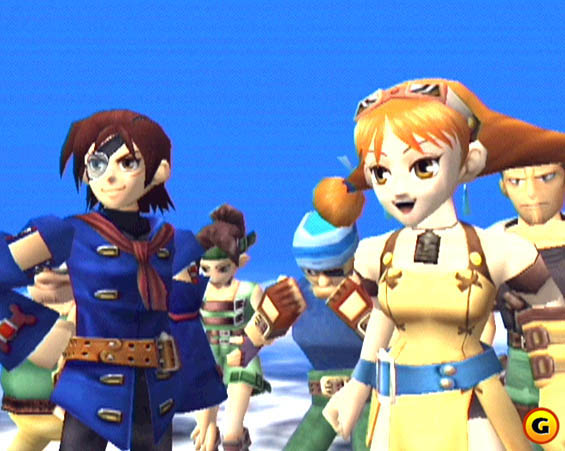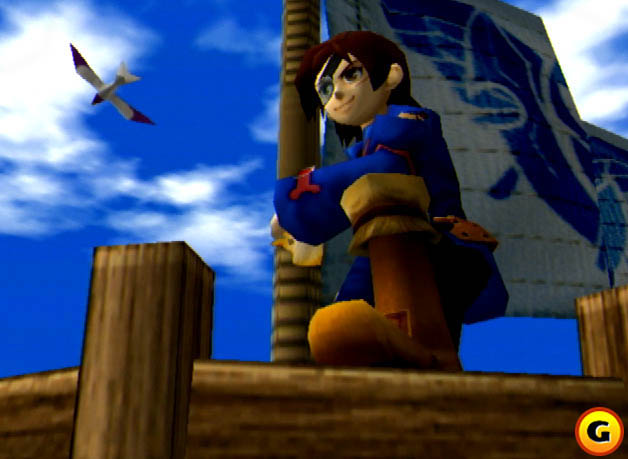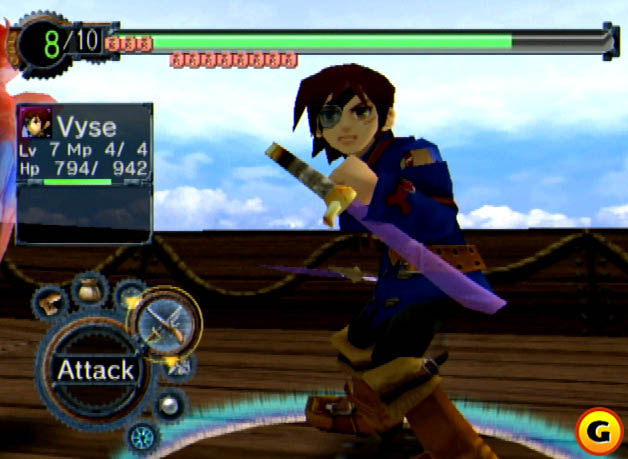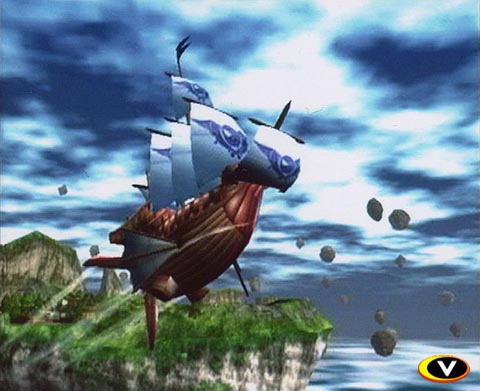A Closer Look at Skies of Arcadia
The development team responsible for the Phantasy Star series is hard at work on Sega's first true RPG for the Dreamcast. Join us in taking a closer look at the game that's bound to be a landmark in the Dreamcast's history.
A Closer Look at Skies of Arcadia

With the Sonic Team currently busy developing Phantasy Star Online, the Phantasy Star series' original development squad has been largely left to pursue other avenues for its grand forms of RPG expression. The result is Skies of Arcadia, Sega's first true RPG for the Dreamcast and a game with a thematic tone that is wholly unique.
Originally known by the enigmatic code name Project Ares, Skies of Arcadia puts one interesting twist on the well-defined set of RPG conventions: All exploration is done via airship, and the game's "field," in effect, is the wild blue yonder. Landmasses lie scattered throughout the cloudy expanses of sky, and the settlements borne by them are both exotic and teeming with life. With the themes of exploration and discovery heavily set into the game's world and narrative, Skies of Arcadia's mood and tone are pleasantly thick and engaging.
An Introduction

Vyse, the game's protagonist, is a member of the Blue Sky Rogues, a faction of pirates with a proper Robin Hood code - stealing only from the moneyed and privileged, the Blue Sky Rogues spread their own brand of justice throughout the world, as likely to plunder an imperial craft as they are to aid a young lass in need.
The game begins as the Blue Sky Rogues launch an attack against a Valuan capital ship - the Valuans being Skies' requisite malevolent superpower. While their original intention was to merely relieve the ship and its crew of their valuables, the Rogues wind up rescuing a captive of the Valuans', a young, fair, mysterious foreigner named Fina. The affluent Valuan Empire would normally just chalk off the plundering of a capital ship as a small loss, but, as their dainty, arrogant, and ultimately ruthless representative Alfonso makes explicit, the loss of Fina is simply unacceptable.
At any rate, Vyse and fellow Blue Rogue Aika proceed to make a mockery of the Valuan forces, succeeding in both their intended looting and the inadvertent saving of a presumably innocent soul. Needless to say, though, they've also succeeded in stoking the rage of Valua, a force, seemingly, that is not to be taken lightly. You can expect high drama to unfold, involving the mysterious foreign traveler, the rage of a highly armed nation, and a cadre of rogues with hearts of gold.
Hands-On: Skies of Arcadia's Battle System

While it contains many elements that are seemingly novel, it's safe to say that, judging from our current impressions, Skies of Arcadia's battle system in no way stretches the conventions we've become familiar with over the years. Combat is strictly turn-based, though the sheer amount of activity on the battlefield will often work to belie the fact. In between characters' actions, inactive party members and enemies exchange blows, feints, and parries, generally dancing around the battlefield, imbuing it with a refreshing degree of life and activity. While the proceedings are purely aesthetic, the effect works quite well, often alleviating much of the humdrum nature of turn-based combat.
The actual mechanics of combat are both multifaceted and straightforward. Most notable is the party's communal "spirit pool." Every time a character acts in battle, the spirit pool gains points, which are used to fuel the entire party's spells and special attacks. You can also opt to have characters "focus" for an entire round, thus spiking your party's spirit pool substantially. Special attacks and spells consume spirit points based on their power, though the latter also consume magic points.
The world's moons - six in all, each pertaining to both a color and an element - play a large part in both the game's narrative and its combat system. Each moon has a set of spells attributed to it. The red moon, for example, governs fire spells and elemental effects, while the purple moon influences all things cold and icy. Once characters are granted access to a moon's spells, they can alter their weapons on the fly to adopt its characteristics. For example, let's say Aika finds herself beset by a horde of fire-using creatures. By hitting the Y button prior to issuing an attack command, you can have her boomerang adopt a purple influence, thus imbuing it with the power of the ice. The use of spells of a certain color, combined with attacking under a certain moon's blessing, allows the character to gain points in the chosen color, granting him or her access to more powerful spells in the moon's portfolio. Thus, it is conceivable to custom-tailor each character and assign him or her specific roles, as the spells native to each moon tend to have well-defined focuses (the green moon's spells tend to be curative, for example, while the red moon's fiery enchantments are mostly offensive in nature). While the system is in no way revolutionary, the actual combat is interesting and fresh in many ways. The constant activity on the battlefield, coupled with the control over minute details that the game grants you, makes for interesting battles that are free, most of the time, of the formulaic proceedings that turn-based combat can easily be consumed by.
Bodies in Motion |
|

Travel in Skies of Arcadia is simply a marvelous thing to behold. Done purely via airship, the field map puts you in a third-person perspective by default, allowing you a decent view of both your ship and the majestic, teeming world. The L and R triggers control altitude, allowing you to wade through the game's vast cloudy skies and granting the game a genuine feeling of depth. The landmasses that dot the gameworld possess both depth and substance, physically and metaphorically. Movement is achieved via the analog stick, which pushes your ship along in a brisk yet seemingly deliberate pace. Clouds drift apart as you pass through them, and friendly ships populate the skies, eager the engage in banter. Random encounters, unfortunately, seem a little too frequent in most areas of the world, heartlessly marring the otherwise idyllic experience that cutting through clouds could be. Whether they're avoidable during later parts of the game remains to be seen, but it would nonetheless be a welcome boon. Any sort of interaction on the world map - be it communicating with a friendly vessel or docking on landmass - is done by pressing the A button when adjacent to and level with the object in question.
In truth, Skies of Arcadia's teeming world has to be seen to be appreciated. Sega has done a magnificent job bringing its vision to life, in terms of the overall production. While there doesn't seem to be anything revolutionary about the game in terms of its systems and play mechanics, the heavily tangible mood and tone are things few RPGs in history, recent or distant, can hold a candle to. Skies of Arcadia has a feel wholly its own, and any Dreamcast owner would do well to indulge in it. Stay tuned to GameSpot next week for a full review of the Japanese version of Skies. Till then, partake of our copious servings of related media.
Got a news tip or want to contact us directly? Email news@gamespot.com
Join the conversation